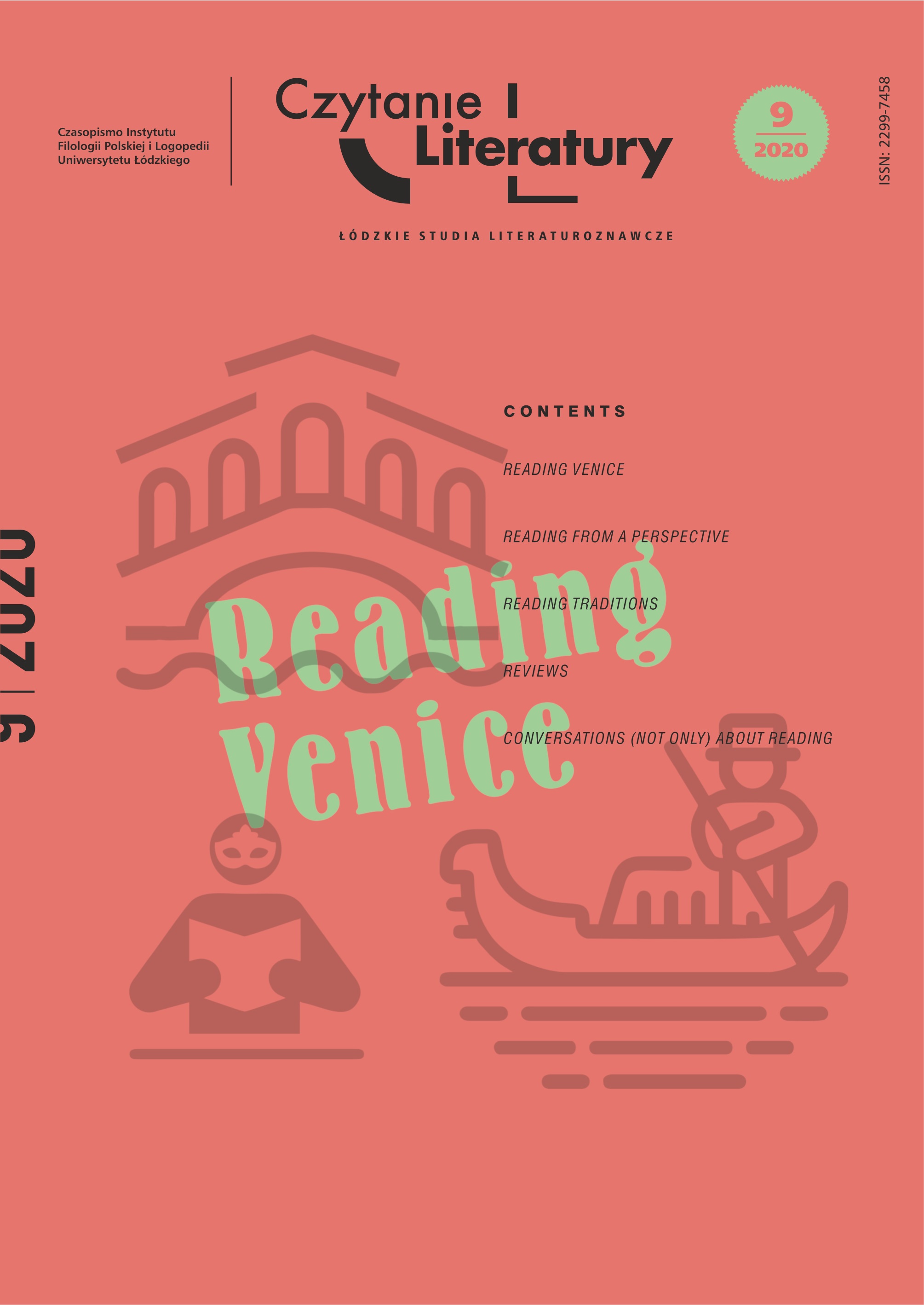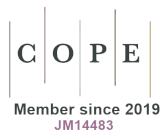Contemporary Icarus: Gustav von Aschenbach’s Journey towards the Sun
DOI:
https://doi.org/10.18778/2299-7458.09.06Słowa kluczowe:
Venice, Mann, sun, mythology, love, decadence, novellaAbstrakt
The point of departure for the reflections contained in this article is the motif of the sun in Tomasz Mann’s Death in Venice. Analysing the presence of the sun in the work turns out to be fruitful for distinguishing and connecting several symbolic planes, on which the issues of Death in Venice and the drama of the main character are depicted: the relationship between contemporary times and antiquity, the cultural North-South axis, the destructive power of beauty as well as the individual fate of the artist marked by decadence. The figure of the sun seems to provide material for the interpretation of the figure of Gustav von Aschenbach as an incarnation of contemporary Icarus and allows the reader to see the path which the protagonist of Death in Venice follows in a new light.
Pobrania
Bibliografia
Achtelik, Aleksandra. Wenecja mityczna w literaturze polskiej XIX i XX wieku. Katowice: Gnome, 2002.
Google Scholar
Ackroyd, Peter. Venice: Pure City. New York: Random House, 2009, 146. Accessed October 24, 2020. https://kingauthor.net/books/Peter%20Ackroyd/Venice/Venice%20-%20Peter%20Ackroyd.pdf
Google Scholar
Alexander, Doris. Creating Literature out of Life. The Making of Four Masterpieces. Pennsylvania: The Pennsylvania State University, 1996.
Google Scholar
Bieńkowska, Ewa. W poszukiwaniu królestwa człowieka. Utopia sztuki od Kanta do Tomasza Manna. Warsaw: Czytelnik, 1981.
Google Scholar
Brann, Eva T.H. “The Venetian Phaedrus.” St. John’s College Digital Archives, 1972. Accessed April 28, 2020. http://digitalarchives.sjc.edu/items/show/1234
Google Scholar
Cunningham, Michael. Introduction. In Mann, Thomas. Death in Venice. Translated by Michael Henry Heim. New York: Harper Collins, 2015.
Google Scholar
Czaja, Dariusz. ”Wenecja i śmierć. Konteksty symboliczne.” Polska Sztuka Ludowa – Konteksty, no. 3–4 (1992): 58–65.
Google Scholar
Encyklopedia Gutenberga. Accessed April, 27, 2020 http://www.gutenberg.czyz.org/word,63594
Google Scholar
Foucault, Michel. Historia seksualności. Tranlated by Bogdan Banasiak, Tadeusz Komendant and Krzysztof Matuszewski. Gdańsk: słowo/obraz terytoria, 2010.
Google Scholar
Jaworska-Witkowska, Monika. “Nienasycenie i ‘niewygasła żywotność’ archetypu wielkiej matki. Misterium ‘rodzącego łona’ jako symbol uniwersalizmu tworzenia.” Rocznik Naukowy Kujawsko-Pomorskiej Szkoły Wyższej w Bydgoszczy. Transdyscyplinarne Studia o Kulturze (i) Edukacji, no. 7–8, 91–106.
Google Scholar
Kurecka, Maria. Czarodziej. Rzecz o Tomaszu Mannie. Krakow: Oficyna Literacka, 1993.
Google Scholar
Lesér, Esther. “An artist’s call and fate: the nature of beauty.” In Lesér, Esther. Thomas Mann’s short fiction. An intellectual Biography. Cranbury: Associated University Presses, 1989, 161–180.
Google Scholar
Mała encyklopedia kultury antycznej. Edited by Zdzisław Piszczek. Warsaw: PWN, 1983.
Google Scholar
Mann, Thomas. Death in Venice. Translated by Helen Tracy Lowe-Porter. In Short Novels by the Masters. Edited by Charles Neider. New York: Cooper Square Press, 2001.
Google Scholar
Mann, Thomas. “Lubeka jako duchowa forma życia.” In Thomas Mann. O sobie: wybór pism autobiograficznych. Warsaw: Czytelnik, 1971, 16–32.
Google Scholar
Muratow, Paweł. Obrazy Włoch. Wenecja. Translated by Paweł Hertz. Warsaw: Wydawnictwo Zeszytów Literackich, 2009.
Google Scholar
Osiński, Alojzy. Słownik mitologiczny z przyłączeniem obrazu-pismo, vol. 1, Warsaw: Drukarnia Xięży Piarów, 1812. Accessed April 29, 2020. http://mbc.cyfrowemazowsze.pl/dlibra/doccontent?id=6161
Google Scholar
Parkes, Ford. The Image of the Tiger in Thomas Mann’s Tod in Venedig. Studies in 20th Century Literature, vol. 3, no. 1, (1978). Accessed 27 April 2020, https://doi.org/10.4148/2334-4415.1060
Google Scholar
DOI: https://doi.org/10.4148/2334-4415.1060
Pausanias. Wędrówka po Helladzie. Księgi I-X. Computer edition, 2003. Accessed April 30, 2020. http://biblioteka.kijowski.pl/antyk%20grecki/%20pauzaniasz%20-%20w%E4%99dr%E3%B3wka%20po%20helladzie%20ks.1-10.pdf
Google Scholar
Perczak, Edward. “Główne kierunki mitologii lunarnej.” Studia Theologica Varsaviensia, no. 1 (1973): 241–254.
Google Scholar
Pieniążek, Paweł. “Anatomia dekadencji.” In Białek Edward, Kowal Grzegorz. Arcydzieła literatury niemieckojęzycznej, vol. 2. Wrocław: ATUT, 2011, 181–192.
Google Scholar
Plato. Państwo. Translated by Władysław Witwicki. Warsaw: PWN, 1958.
Google Scholar
Plato. The Phaedrus. Translated by Benjamin Jowett. The Project Gutenberg EBook of Phaedrus, last modified January 15, 2013. Accessed October 25, 2020, http://www.gutenberg.org/files/1636/1636-h/1636-h.htm
Google Scholar
Rogalski, Aleksander. Tomasz Mann. Dzieje rozwoju osobowości twórczej. Warsaw: Instytut Wydawniczy PAX, 1975.
Google Scholar
Sizemore, John, Jr. “An analysis of art represented in classical mythology in Mann’s Death in Venice,” International Jornal of Arts & Sciences (2014). Accessed 27 April 2020, http://www.universitypublications.net/ijas/0705/pdf/H4V180.pdf
Google Scholar
Smith, William. A dictionary of the Greek and Roman Biography and Mythology. Boston: Little, 1887.
Google Scholar
Stabryła, Stanisław. Zarys kultury starożytnej Grecji i Rzymu. Warsaw: Wydawnictwo Naukowe PWN, 2007.
Google Scholar
Tatarkiewicz, Władysław. Historia filozofii, vol. 1. Warsaw: Wydawnictwo Naukowe PWN, 2009.
Google Scholar
Willis, Louise. “The Representation of Instinctive Homosexuality and Immoral Narcissism in Gide’s The Immoralist (1902) and Mann’s Death in Venice (1912),” CLCWeb: Comparative Literature and Culture (2017). Accessed April 27, 2020. https://doi.org/10.7771/1481-4374.2960
Google Scholar
DOI: https://doi.org/10.7771/1481-4374.2960
Wołk, Marcin. Głosy labiryntu. Od “Śmierci w Wenecji” do “Monizy Clavier.” Toruń: Wydawnictwo Naukowe Uniwersytetu Mikołaja Kopernika, 2009.
Google Scholar
Zipper, Albert. Mitologia Greków i Rzymian. Złotów: Wydawnictwo Księgarni Wilhelma Zukerkandla, 1896.
Google Scholar
Pobrania
Opublikowane
Jak cytować
Numer
Dział
Licencja

Utwór dostępny jest na licencji Creative Commons Uznanie autorstwa – Użycie niekomercyjne – Bez utworów zależnych 4.0 Międzynarodowe.










